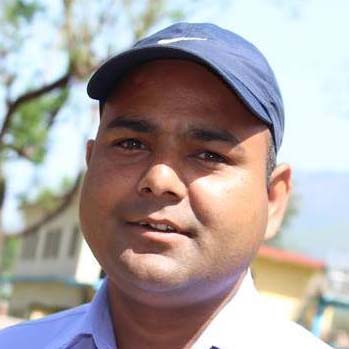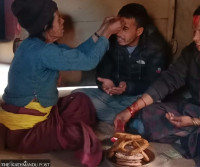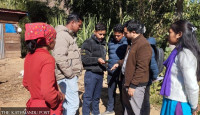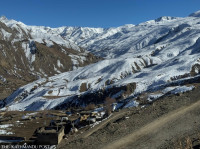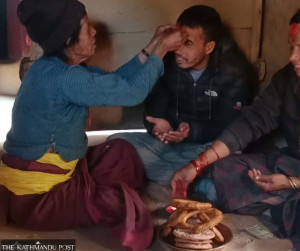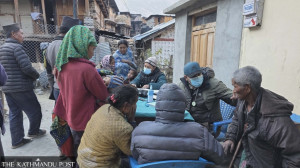Karnali Province
Taklakot is a lifeline for Humla residents
Tibetan town becomes main job destination for families in Nepal’s remotest district.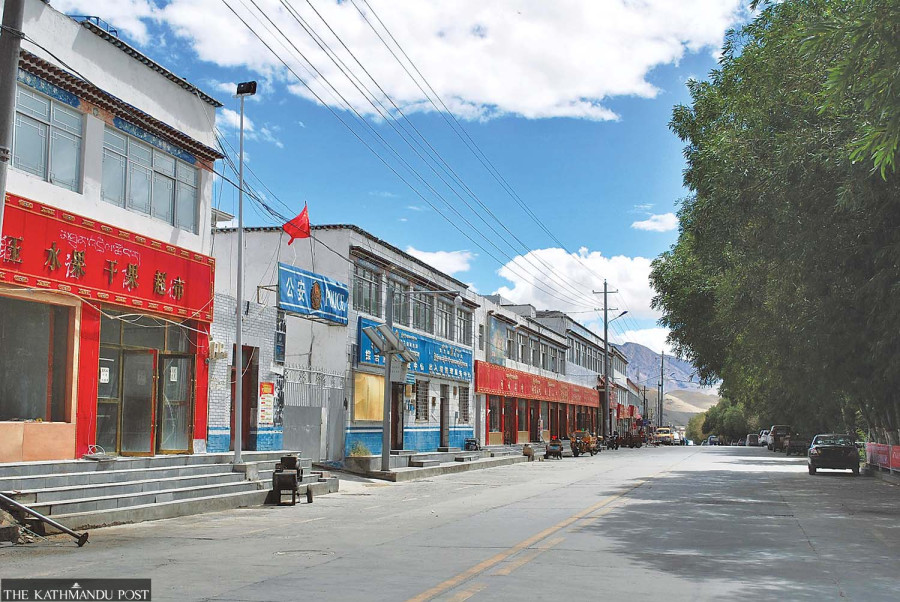
Krishna Prasad Gautam
Pasang Chhomten Lama from ward 4 of Namkha Rural Municipality in Humla has been crossing the border into China’s Taklakot for work for nearly 11 years. When the Hilsa border point remained closed for four years due to the Covid pandemic, his family’s livelihood was greatly affected.
“It is the Nepalis who carry loads, load and unload trucks, and repair roads there,” said Pasang. “One can earn up to Rs150,000 a month doing such work, which is why Taklakot has become the main destination for us Humlis.”
Pasang has already received a border pass from the district administration office in Humla and is preparing to leave again in two weeks.
Like him, Lokjung Budha of ward 7 of Simkot Rural Municipality is also making arrangements to go. He managed to buy land in the district headquarters with his earnings from Taklakot over the past decade.
“There are no jobs at home. If I work in Taklakot for just six months, I can cover household expenses for the whole year,” he said. “Even basic labour pays well there, and our survival has come to depend on it.”
With the reopening of Hilsa in April last year, the flow of workers has surged again. According to Chief District Officer Narayan Pandey, 10,955 people have so far taken border passes—8,237 new and 2,718 renewals. He said that 15 to 50 people apply daily. The passes are valid for a year and are issued for free to Humla residents, allowing them to go 30 kilometres inside China, up to Taklakot.
But without a labour agreement between Nepal and China, workers are denied fair wages, insurance, and other benefits. Local authorities pay them at rates below Chinese standards, leaving them vulnerable. Only in cases of injury have some gotten medical treatment.
Taklakot, the headquarters of Tibet’s Purang County, has experienced rapid development in recent years, making it a reliable source of jobs. Daily wage workers can earn around 300 yuan (around Rs5,800), said Pemba Tamang of ward 5 of Namkha Rural Municipality. With food cheap and housing costing only Rs15,000 to Rs25,000 a month, workers can save most of their earnings.
“Even three or four months of work can support a family for a year,” Tamang said. He explained that most Humla residents work as porters, construction hands, or as hotel/restaurant workers during the warmer months, returning before heavy snow in December.
Many also supplement their income with trade. According to Namgyal Tamang, former president of Humla Chamber of Commerce and Industry, nearly 70 percent of the youth from Namkha and Simkot work in Taklakot, and some bring children along.
The herbal trade is also flourishing across the border. Medicinal plants such as yarsagumba fetch between Rs2-2.4 million per kilogram in Taklakot, compared to far less in Kathmandu, where traders face high taxes and middlemen. “In Nepal, we suffer bureaucratic hassles and poor prices. In Taklakot, the market is stronger and more direct,” Tamang said.
For many in Humla, Taklakot is what the Gulf states or Europe are for other Nepalis. Karna Bahadur Rawal, a Simkot-based trader, said his eldest son already left for Talkakot for work two months ago. “The border closure during the Covid pandemic was like losing our food supply,” he said. “Now we hope things will improve again.”
Workers usually leave between March and April and return by mid-December, carrying back household goods and savings of up to Rs400,000 each.
The dependency reflects deep structural problems at home. Namkha Rural Municipality chairman Prem Bahadur Lama said agriculture is unviable in many areas due to harsh weather and lack of irrigation.
Most families grow a single crop of barley, enough for three months at best. Livestock and wild herb collection provide some income, but not enough to sustain households. “Here, a family that can eat for three months is considered well-off,” he said. “That is why labour migration to Taklakot has become a source of survival.”
The movement has revived the Hilsa border town, which lay dormant during the pandemic. Ward chair Paljor Lama of Hilsa said up to 50 locals cross daily, while traders and Indian pilgrims heading for Kailash Manasarovar have boosted business.
Around 35 tourist hotels in Hilsa, which were once struggling, are now filling up, while Chinese goods such as rice and flour are again reaching Humla. Regular transport services now operate between Simkot and Hilsa, a sign of growing cross-border activity. Indian pilgrims traveling to Kailash Manasarovar have also added to the flow, with between 150 and 300 arriving daily.
For Humla residents, the dependence on Taklakot reflects both opportunity and vulnerability. The town across the border provides jobs and markets unavailable in Nepal’s remotest district, but the absence of formal labour agreements leaves thousands without protection. “Going to Taklakot is not a choice. It is a matter of survival,” said a worker returning from Taklakot.




 16.12°C Kathmandu
16.12°C Kathmandu